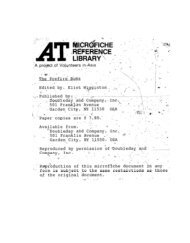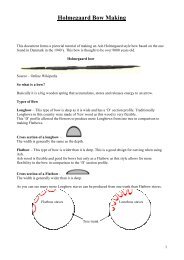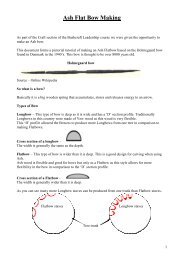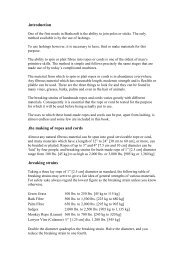Experiments on Knife Sharpening John D. Verhoeven ... - BushcraftUK
Experiments on Knife Sharpening John D. Verhoeven ... - BushcraftUK
Experiments on Knife Sharpening John D. Verhoeven ... - BushcraftUK
You also want an ePaper? Increase the reach of your titles
YUMPU automatically turns print PDFs into web optimized ePapers that Google loves.
[2] <str<strong>on</strong>g>Experiments</str<strong>on</strong>g> with the Tru H<strong>on</strong>e knife sharpening machineAppendix 3 presents a fairly detailed descripti<strong>on</strong> of the Tru H<strong>on</strong>e sharpeningmachine used in these experiments. The stainless steel blades of Fig. 5 were sharpened ingroups of 4 using the special holder attachment shown in Fig. A10. The holder insuredthat the blades were held exactly vertically between the sets of sharpening wheels andthat the downward pressure could be maintained essentially c<strong>on</strong>stant <strong>on</strong> all 4 blades. Thespeed c<strong>on</strong>trol knob is calibrated from S = 1 to 10 (slowest to fastest). The generalprocedure used here was to pass the blades back-and-forth 5 to 10 times with <strong>on</strong>ly a lighthand pressure using the fastest speed and then to finish with 1 to 2 b & f passes under<strong>on</strong>ly the pressure of the holder blade at the slowest speeds of 1 to 2 <strong>on</strong> the speed c<strong>on</strong>trolknob. The grind angle was set to desired values using the procedure described in App. 3.Unless otherwise stated, the work was d<strong>on</strong>e by simply regrinding the T edge of theblades, shown <strong>on</strong> Fig. 5, to a 2β edge angle of 39-41 o . Blades ground with the 100, 220,400 and 600 grit aluminum oxide wheels were all ground dry. The special 1000 gritwheels were used wet. These wheels appear smoother than the standard aluminum oxidewheels, as if the oxide particles are held in a resin material. They were always usedfollowing a grind with the 600 grit oxide wheels. The 2β edge angle was increased a fewdegrees (from 38.8 to 41.3 o ) to ensure that <strong>on</strong>ly the edge regi<strong>on</strong> was being ground.A set of comparis<strong>on</strong> SEM micrographs of the as-ground blades is presented inFigs. 10 to 12. There does not seem to be a real significant difference in blades groundwith the 220 grit wheels versus the 600 grit wheels. Both have significant burs <strong>on</strong> theground edge and both have fairly rough edges in the face views accompanied by wideabrasive ploughing marks al<strong>on</strong>g the face surfaces. The 1000 grit wheels produces asignificant improvement in the ground surfaces. The face views show a much reducedsize in the groove marks from the abrasive acti<strong>on</strong> of the wheels, and the edges are nowmuch smoother. The edge view shows that a small distinct bur occurs <strong>on</strong> the edge havingan edge width which was measured <strong>on</strong> several blades and found to average 1 to 1.5micr<strong>on</strong>s. It was found that the edge width was increased over these values if the 1000grit wheels were used dry or if the final pass was not d<strong>on</strong>e under light pressure at theslowest wheel speeds.It was thought that because the wheels of the Tru H<strong>on</strong>e machine rotated towardthe edge during grinding that the abrasive debris would be carried away from the edgeand therefore very little bur would be formed al<strong>on</strong>g the edge. This is clearly not the case,especially for the wheels of 600 grit and coarser. There must be some type of mechanismthat deposits debris al<strong>on</strong>g the edge, even with the wheels rotating into the edge. Perhapsit involves debris that clings to the wheels and comes around and is deposited off thewheels as the blade edge emerges from the final wheel that it c<strong>on</strong>tacts.CATRA produces a sharpening machine similar to the Tru H<strong>on</strong>e machine in thatit employs the same geometry of wheels and knife orientati<strong>on</strong> as shown <strong>on</strong> the left side ofFig. A11. This machine employs a special spiral locking of the grinding wheels.Comparis<strong>on</strong> of blades ground <strong>on</strong> these machines with those ground <strong>on</strong> the Tru H<strong>on</strong>e8








